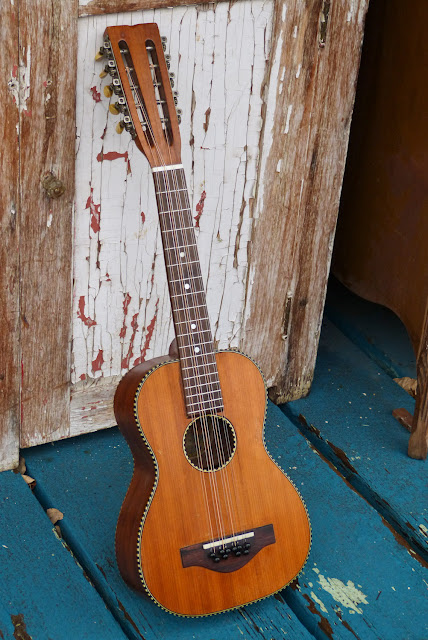1930s Harmony-made Bruno Tiple
I mostly try to avoid tiples if I can help it, these days. I've worked on a lot of them and they're very fun instruments when they're done but they are quite fussy to repair and setup as the original designs were -- shall we say -- not quite on the money.
This one was sent in via a customer and, fortunately, some of the work was done before it got to my doorstep, if not particularly beautifully-executed! The neck was reset (not at a great angle and with a ginormous neck block installed under the hood), cracks were repaired more-or-less, and the whole instrument was top-coated or refinished. There were even some odd little cut-outs made to the headstock for decorative purposes, methinks.
My own work involved getting it playable -- which included a board plane and refret (the neck was warped a little and the frets were paper-thin), bridge modification, new bone nut and fully-compensated bone saddle, tuner adjustments and lube, and general setup.
Materials-wise this is a nicer-grade Harmony-made product from the time with a solid spruce top, solid mahogany back and sides, cool "checker" celluloid binding, a Brazilian rosewood bridge, a mahogany neck, and a stained-maple (typical) fretboard. There are multiple repaired old hairline cracks throughout.
Tiples are the size of tenor ukuleles and have 10 strings in a 2-3-3-2 format. The standard tuning "back in the day" was ADF#B, though folks these days prefer GCEA. I've strung it for GCEA with a custom set of string: 10/22w, 17/38w/17, 14/30w/14, 9/9. The standard tiple sets seem to have gauges too light in some places and too tense in others.
Note that there are octaves on all but the top course. I used to octave that course on my own tiple, too, but have returned to the standard stringing style (like this) as it gives a nice chimey high string to zip mandolin-style solos on.
The new frets are "modern banjo-sized" and feel great. Action is spot-on at 1/16" at the 12th fret.
Unfortunately, the old repairs to the tiple included a lot of binding that was reglued irregularly and a pinched neck joint area that wasn't adjusted when a new neck block was put in.
The original configuration of the bridge would've looked like the one on this Martin. Because I didn't want to operate on the already-funky neck pocket to get a taller saddle, it meant that I needed to improve break-angle over the saddle somehow.
I hacked the "tie block" off of the top of the bridge -- which is something I've done to multiple tiples as the tie block tends to get hairline cracks and die on its own -- and converted it to a pin-bridge setup. This is a lot more practical.
I then cleaned-up, polished, and finished the bridge to match its earlier look and made a fully-compensated (note the notches for each string) bone saddle. The black pins are all from my parts-bin pulls and have some age to them which makes them fit-in more.
There's a hairline crack when tuned to pitch (as expected) in the bridge behind where the old tie-block was located. This is really typical because it's the "pinch point" for tension on the tie-block bridge types, but it only goes down a hair and so I'm leaving it as an acceptable problem.
The mahogany on the back and sides is nice-looking stuff.
The tuners needed lube and a few missing screws replaced, but otherwise they work pretty well for period units. The buttons are ivoroid.
















Comments